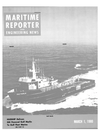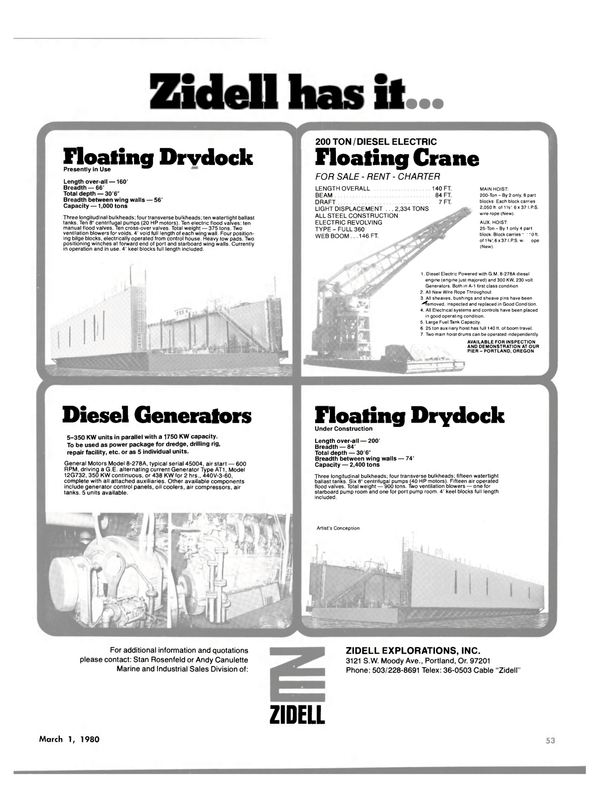
Student Paper Presented At The New England Section Of SNAME
At the fourth meeting of the New England Section of The Society of Naval Architects and Marine Engineers, Todd P^ltzer, Ensign, USN, presented a paper entitled "On the Use of High-speed Photography in the S t u d y of P r o p e l l e r Cavitation." Ensign Peltzer is a recent graduate at the Massachusetts Institute of Technology, having received his S.B. degree in naval architecture and marine engineering in June 1979.
The speaker discussed in detail research conducted at M.I.T. during the 1978-79 academic year, involving the use of high-speed photography in the study of propeller cavitation.
The objective of this research was to obtain a set of photographs from which the extent of cavitation could be determined quantitatively. As background, the significance of such measurements to the general study of cavitation was discussed. The difficulties encountered in previous attempts at the use of high-speed photography in cavitation research were also discussed.
The solution to these problems was the motivation for the use of some advanced photographic techniques. In particuar, the introduction of Kodak Ektachrome 400 film, and the development of a digital time-delay unit made possible a detailed photographic survey of propeller cavitation. These photographic techniques formed the basis for experiments which produced a series of photographs of a five-bladed, gold-anodized propeller, taken at one degree intervals, and at cavitation indices of 2.05, 2.5, and 3.0.
While the quality of these photographs was excellent, geometrical distortions precluded any meaningful quantitative measurements of cavitation extent.
This problem inspired further experimentation using a four-bladed brass propeller.
Here, the fixed wake screen used in the previous experiment was replaced by a rotatalile wake screen, allowing the propeller to be photographed in a singe orientation and yet still achieve the desired variation in flow. From these measurements, an estimation of cavity volume was made yielding a history of cavity formation and collapse.
These volume estimates very closely agree, within experimental limits, with the prediction of a numerical lifting surface computer model.
Read Student Paper Presented At The New England Section Of SNAME in Pdf, Flash or Html5 edition of March 1980 Maritime Reporter
Other stories from March 1980 issue
Content
- Marine Contractors Begins Work On $68-Million Turnkey Project page: 4
- Megasystems Receives Contracts To Equip Two Amoco Vessels page: 6
- Borkowski And Windell Promoted At State Boat page: 6
- N e w Container Cranes For Port Of O a k l a nd Expansion Program page: 6
- R.B. Inserra Appointed VP-Engineering/Operations At Atlantic Diving Co. page: 7
- ASSOPO '80 Set For June 16-18 In Trondheim —Program Available page: 7
- Pentimonti Appointed VP-Engineering At APL page: 8
- 'Birgit-N'— First Crabber/Trawler From Tacoma Boatbuilding For Bering Sea Service page: 8
- D r i l l i n g Rig Delivered To M a r i n e Drilling Co. By Bethlehem Steel page: 8
- Willard G. Olmstead Named VP And Controller At Federal Barge Lines page: 9
- 'How-To' Manual For Oil-Spill Cleanup Available From EPA page: 9
- M a n d a t o r y Use Of C o l l i s i o n A v o i d a n ce E q u i p m e n t Proposed page: 9
- A l l e n R. Stern N a m ed President Of I n g r am E x p l o r a t i o n C o m p a ny page: 9
- Canada To Seek Bids On $C43-Million Drydock For Use At Halifax Shipyards page: 10
- Bandon Elected VP And General Manager Of Curtis Bay Towing Of Pa. page: 10
- H.T. Wilson Joins Adams & Porter Assoc. page: 11
- Webb Seeks Applications For New Assistantship page: 11
- API Announces 1980 T a n k e r Conference Set For M a y 11-14 page: 11
- Bruce W e i n s t e in A p p o i n t e d C o o r d i n a t or At B u t t e r w o r t h Systems page: 11
- B&W Shipyard Delivers M / S ' W h i t e Nile' page: 12
- Gulf Fleet M a r i n e Adds 9 5 t h Vessel To Expanding O f f s h o r e Service Fleet page: 12
- M A R C O O f f e r s Literature On T r a w l i n g / S e i n i n g Winch page: 12
- N o r m a n Meyer A p p o i n t ed VP Of Sperry Unit page: 12
- Nashville Bridge Co. Plans Major Expansion At Ashland City Yard page: 14
- Ship Operations Symposium And Exhibit To Be Held Sept. 23-25 In N.Y. City page: 14
- Joint M e e t i n g Held By SNAME C h e s a p e a k e / A S N E Flagship Sections page: 14
- McDermott Restructures O p e r a t i n g Unit Into Five A r e a s Of Responsibility page: 14
- Peterson Builders Launches The Captain Frank Medina page: 17
- Mitsubishi Appoints Oosterhuis Industries Gulf Coast Distributor For Diesel Engines page: 18
- H o n g k o n g United Dock Ships 210-Ton Buoy For PEMEX page: 18
- New Technical Services Brochure Available From Atlantic Diving Co. page: 19
- Junana Delivered To NDC Of Abu Dhabi By Hitachi Zosen page: 19
- $ 3 5 - M i l l i o n Two-Rig Contract For I n g a l ls page: 20
- S i n g a p o r e Signs Contract For Imodco H a r b o r T e r m i n al page: 20
- e l f - D u m p i n g Barge Launched By FMC page: 22
- J . J . Henry Co. Opens Houston Office page: 28
- Three Papers Presented At Winter Meeting Of SNAME Great Lakes And Great Rivers Section page: 34
- B&W Reports Hong Kong Engine Orders For 1980-81 page: 35
- Gulf Oil Trading And Transportation Division Will Move To Houston page: 36
- Fully Automated Containership Nichigoh Maru Delivered By Hitachi page: 36
- Bulkfleet Ma rine Elects G.J. Mount V-P page: 36
- Navidyne Receives Orders For Satellite Navigation Systems page: 38
- Zapata Orders Three Rigs Costing $105 Million page: 38
- Perry Oceanographies, Inc. Offers Services And Products Brochures page: 38
- Kaune Named Assistant General Manager At Todd-San Francisco page: 39
- Three Key Appointments Announced At Solus Ocean Systems, Aberdeen page: 39
- Specifications Available On New Model Facsimile Receiver By Raytheon page: 40
- Gerald Albert Promoted To President Of EDO Corp. page: 40
- Two Vice Presidents Appointed At Texas Gas Transmission Division page: 42
- Ship Dynamic Positioning & Mooring Systems Conference —Papers Available In Booklet Form page: 42
- Technical Management Reorganization Announced By B&W Engineering page: 42
- John G. Rogers Appointed Facility Services Manager At Bethlehem Steel Corp. page: 42
- FOURTH FOR TMT CHRISTENED page: 44
- NMC Appoints Two U.S.-Flag Officials page: 44
- Morris Guralnick Assoc. Names Darrel W. Starr Jr. Chief Mechanical Engineer page: 44
- IHI Completes Accommodation Barge For Abu Dhabi Oilfield page: 44
- Lockheed Offshore Systems Opens Houston Branch Office page: 45
- McDermott Unit Names Five New Vice Presidents page: 45
- Use Of Combustion To Combat Oil Spills —Report Available page: 46
- McDermott Norge Receives $100-Million Amoco Norway Letter Of Intent page: 46
- R.J. Brown & Associates Receive Esso Contract For Pipeline Post-Trenching Plow page: 46
- TANO Wins $2.6-Million Contract For Marine Automation Systems page: 47
- Student Paper Presented At The New England Section Of SNAME page: 47
- Free Bulletins Describe Pourable Epoxy Resin Chocking System page: 48
- Hakenjos Named President Of A.G.C. Chapter page: 48
- SNAME San Diego Section Discusses LHA Rampwell Design page: 50
- George C. Cassa Promoted At J . J . Henry Co page: 50
- Bauer Elected President Engineering Controls page: 51
- P. Takis Veliotis Elected Executive VP-Marine At General Dynamics page: 51
- Sun Ship 'Christens' New Living Accommodations For Navy Crews page: 52
- Jumbo America, Inc.—New Heavy-Lift Co. Formed page: 52
- Schnitzer-Leven Marine Company Names Hemphill Marine Services Manager page: 52
- Literature Describes New Gems Shock Cushioned Liquid Level Switch page: 52
- John Farris Named To Planning Post At Pall Corporation page: 53
- Information Available On Oil Containment Boom page: 53
- N.Y. Metropolitan Section SNAME Hears Technical Paper On Finite Element Analysis Techniques page: 54
- Portable Ventilation Equipment Catalog Offered By Coppus page: 54
- Harry R. Kraus Appointed VP At Dravo Division page: 54
- Port Of New Orleans Mariners Club Elects New Officers & Directors page: 55
- Vickers Limited Announces Acquisition Of Jered Industries page: 56
- NASSCO Appoints Two To New Executive Posts page: 56
- Two Unique Proposals By Seaforth Maritime page: 56


